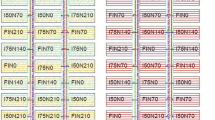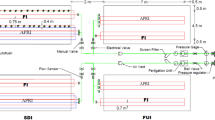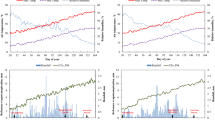Abstract
A 2-year field experiment was conducted with the objectives to evaluate the physiological and yield response of quinoa cv Titicaca to various deficit irrigation strategies applied with surface drip (SD) and subsurface drip systems (SSD) under the Mediterranean climatic conditions in 2016 and 2017. The treatments consisted of regulated deficit irrigation (RDI), partial root-zone drying (PRD50), conventional deficit irrigations (DI50, DI75) and full irrigation (FI) under SD and SSD. A rainfed treatment was also included. The experimental design was split plots with four replications. DI75 and DI50 received 75 and 50% of FI, respectively. PRD50 plots received 50% of FI, but from alternative laterals in each application. RDI received 50% of FI during vegetative stage until flowering, then received 100% of water requirement. The results indicated that RDI resulted in water saving of 23 and 21% for surface drip (SD) and SSD systems, respectively, and RDI produced statistically similar yield to FI treatment in both experimental years. DI75 treatment resulted in water savings of 16% for both drip methods in the first year and 10 and 25% for SD and SSD systems, respectively, in the second year. Thus, RDI and DI75 treatments appear to be good alternative to FI for sustainable quinoa production in the Mediterranean environmental conditions. Greater leaf water potential (LWP) and smaller crop water stress index (CWSI) values were measured in FI plots under both drip systems than deficit irrigation treatment plots. Significant second-order polynomial relations were determined between CWSI and LWP for the drip systems. Leaf area index (LAI), LWP decreased and CWSI increased as the drought increased. CWSI correlated significantly (P < 0.01) and negatively with grain yield, dry matter yield, LAI, and mean soil water content indicating that grain yield of quinoa declined with increasing CWSI values. All these relations are best described by significant second-order polynomial equations. The results revealed that quinoa should be irrigated at LWP values between − 1.35 and − 1.60 MPa, and average CWSI value of approximately 0.35 for high yields.









Similar content being viewed by others
Explore related subjects
Discover the latest articles and news from researchers in related subjects, suggested using machine learning.References
Adolf VI, Jacobsen SE, Shabala S (2013) Salt tolerance mechanisms in quinoa (Chenopodium quinoa Willd.). Environ Exp Bot 92:43–54
Ahmadi SH, Solgi S, Sepaskhah AR (2019) Quinoa: a super or pseudo-super crop? Evidences from evapotranspiration, root growth, crop coefficients, and water productivity in a hot and semi-arid area under three planting densities. Agric Water Manag 225:105784
Alghory A, Yazar A (2019) Evaluation of crop water stress index and leaf water potential for deficit irrigation management of sprinkler-irrigated wheat. Irrig Sci 37:61–77
Alvar-Beltran J, Saturnin C, Dao A, Marta AD, Sanou J, Orlandini S (2019) Effect of drought and nitrogen fertilisation on quinoa (Chenopodium quinoa Willd.) under field conditions in Burkina Faso. Ital J Agrometeorol 1:33–43
Alves I, Pereira LS (2000) Non-water-stressed baselines for irrigation scheduling with infrared thermometers: a new approach. Irrig Sci 19:101–106
Argyrokastritis IG, Papastylianou PT, Alexandris S (2015) Leaf water potential and crop water stress index variation for full and deficit irrigated cotton in Mediterranean conditions. Agric Agric Sci Procedia 4:463–470
Bonet L, Ferrer P, Castel JR, Intrigliolo DS (2010) Soil capacitance sensors and stem dendrometers. Useful tools for irrigation scheduling of commercial orchards? Span J Agric Res 8:852–865
Bozkurt Çolak Y, Yazar A, Çolak İ, Akça H, Duraktekin G (2015) Evaluation of crop water stress index (CWSI) for eggplant under varying irrigation regimes using surface and subsurface drip systems. Agric Agric Sci Procedia 4C:372–382
Bozkurt Çolak Y, Yazar A, Sesveren S, Colak I (2017) Evaluation of yield and leaf water potential (LWP) for eggplant under varying irrigation regimes using surface and subsurface drip systems. Sci Hortic 219:10–21
Bozkurt Çolak Y, Yazar A, Gönen E, Eroğlu EÇ (2018) Yield and quality response of surface and subsurface drip irrigated eggplant and comparison of net returns. Agric Water Manag 206:165–175
Chai Q, Gan Y, Zhao C, Xu HL, Waskom RM, Niu Y, Siddique KHM (2016) Regulated deficit irrigation for crop production under drought stress A review. Agron Sustain Dev 36:3
Chen J, Lin L, Lü G (2010) An index of soil drought intensity and degree: an application on corn and a comparison with CWSI. Agric Water Manag 97:865–871
Cocozza C, Pulvento C, Lavini A, Riccardi M, d’Andria R, Tognetti R (2012) Effects of increasing salinity stress and decreasing water availability on ecophysiological traits of quinoa (Chenopodium quinoa Willd.). J Agron Crop Sci 199:229–240
Costa M, Ortuño MF, Chaves MM (2007) Deficit irrigation as a strategy to save water: Physiology and potential application to horticulture. J Integr Plant Biol 49(10):1421–1434
DeJonge KC, Taghvaeian S, Trout TT, Comas LH (2015) Comparison of canopy temperature-based water stress indices for maize. Agric Water Manag 156:51–62
English MJ, Musick JT, Murty VVN (1990) Deficit irrigation. In: Hoffman GJ, et al. (eds) Management of farm irrigation systems. ASAE Monograph, St. Joseph, pp 631–655
Evett SR, Stone KC, Schwartz RC, O'Shaughnessy SA, Colaizzi PD, Anderson SK, Anderson DJ (2019) Resolving discrepancies between laboratory-determined field capacity values and field water content observations: Implications for irrigation management. Irrig Sci 37(6):751–759
FAO (2006) Guidelines for soil description. Food and Agriculture Organization of the United Nations, Rome
Fereres E, Evans RG (2006) Irrigation of fruit trees and vines: an introduction. Irrig Sci 24:55–57
Fghire R, Wahbi S, Anaya F, Issa Ali O, Benlhabib O, Ragab R (2015) Response of quinoa to different water management strategies: field experiments and SALTMED model application results. Irrig Drain 64(1):29–40
Fghire R, Anaya F, Issa Ali O, Wahbi S (2017) Physiological and growth response traits to water deficit as indicators of tolerance criteria between quinoa genotypes. J Mater Environ Sci 8(6):2084–2093
Galwey N, Leakey CLA, Price KR, Fenwick GR (1989) Chemical composition and nutritional characteristic of quinoa (Chenopodium quinoa Willd.). Food Sci Nutr 42:245–261
Garcia M, Vacher J, Hidalgo J (1991) Actas del VII Congreso Internacional sobre Cultivos Andinos. IBTA-Orstom-CIID, La Paz
Garcia M, Raes D, Jacobsen SE (2003) Evapotranspiration analysis and irrigation requirements of quinoa (Chenopodium quinoa) in the Bolivian highlands. Agric Water Manag 60(2):119–134
Geerts S, Raes D (2009) Deficit irrigation as an on-farm strategy to maximize crop water productivity in dry areas. Agric Water Manag 96:1275–1284
Geerts S, Mamani RS, Garcia M, Raes D (2005) Response of quinoa (Chenopodium quinoa) to differential drought stress in the Bolivian Altiplano: towards a deficit irrigation strategy within a water scarce region. PhD thesis. Leuven, Belgium, Faculty of Bioscience Engineering Laboratory for Soil and Water Management 9
Geerts S, Raes D, Garcia M, Vacher J, Mamani R, Mendoza J, Huanca R, Morales B, Miranda R, Cusicanqui J, Taboada C (2007) Introducing deficit irrigation to stabilize yields of quinoa (Chenopodium quinoa Willd.). Eur J Agron 28:427–436
Geerts S, Raes D, Garcia M, Vacher J, Mamani R, Mendoza J, Huanca R, Morales B, Miranda R, Cusicanqui J (2008) Introducing deficit irrigation to stabilize yields of quinoa (Chenopodiumquinoa Willd.). Eur J Agron 28:427–436
Geerts S, Raes D, Garcia M, Taboada C, Miranda R, Cusicanqui J, Vacher J (2009) Modelling the potential for closing quinoa yield gaps under varying water availability in the Bolivian Altiplano. Agric Water Manag 96(11):1652–1658
Hinojosa L, González JA, Barrios-Masias FH, Fuentes F, Murphy KM (2018) Quinoa abiotic stress responses: a Review. Plants 7(4):106
Hirich A, Choukr-Allah R, Jacobsen SE, Benlhabib O (2012) Could quinoa be an alternative crop of wheat in the Mediterranean Region: case of Morocco? Les notes d’alerte du CIHEAM. N°86-Octobre 2012:1–8
Hirich A, Choukr-Allah R, Jacobsen SE (2014) The combined effect of deficit irrigation by treated wastewater and organic amendment on quinoa (Chenopodium quinoa Willd.) productivity. Desalin. Water Treat 52(10–12):2208–2213
Hirich A, Jelloul A, Choukr-Allah R, Jacobsen SE (2014) Saline water irrigation of quinoa and chickpea: seedling rate, stomatal conductance and yield responses. J Agron Crop Sci 200(5):378–389
Hsioa T (1990) Measurements of plant water status. In: Steward B, Nielsen D (eds) Irrigation of agricultural crops. Agronomy Monographs, Madison, pp 243–279
Idso SB, Jackson RD, Pinter PJ Jr, Reginato RJ, Hatfield JL (1981) Normalizing the stress-degree-day parameter for environmental variability. Agric Meteorol 24:45–55
Irmak S, (2005) A Brief Research Update on Subsurface Drip Irrigation. UNL-Extension Circular EC-776, UNL, Lincoln, Nebraska, USA.
Irmak S, Djaman K, Rudnick D (2016) Effect of full and limited irrigation amount and frequency on subsurface drip-irrigated maize evapotranspiration, yield, water use efficiency and yield response factors. Irrig Sci 34(4):271–286
Issa Ali O, Rachid F, Anaya F, Benlhabin O, Sait W (2019) Physiological and morphological responses of two quinoa cultivars (Chenopodium quinoa Willd.) to drought stress. Gesunde Pflanzen 71(2):123–133
İnce Kaya Ç (2015) Investigation of Yield Physiological Responses of Quinoa (Chenopodium Quinoa Wild.) at Different Salinity and Irrigation Levels in Mediterranean Conditions and Testing of SALTMED Model. PhD Thesis, Cukurova University, Adana, Turkey.
Jacobsen SE, Stolen O (1993) Quinoa—morphology, phenology and prospects for its production as a new crop in Europe. Eur J Agron 2(1):19–29
Jacobsen SE, Mujica A, Jensen CR (2003) The resistance of quinoa (Chenopodium quinoa Willd.) to adverse abiotic factors. Food Rev Int 19:99–109
Jacobsen SE, Monteros C, Christiansen JL, Bravo LA, Corcuera LJ, Mujica A (2005) Plant responses of quinoa (Chenopodium quinoa Willd.) to frost at various phenological stages. Eur J Agron 22:131–139
Jacobsen SE, Monteros C, Corcuera LJ, Bravo LA, Christiansen JL, Mujica A (2007) Frost resistance mechanismsin quinoa (Chenopodium quinoa Willd.). Eur J Agron 26:471–475
Jacobsen SE, Liu F, Jensen CR (2009) Does root-sourced ABA play a role for regulation of stomata under drought in quinoa (Chenopodium quinoa Willd.). Sci Hortic 122:281–287
Jacobsen SE, Jensen CR, Lui F (2012) Improving crop production in the Mediterranean climate. Field Crops Res 128:34–47
Jensen C, Jacobsen SE, Andersen M, Andersen S, Mogensen V, Núñez N, Rasmussen L (2000) Leaf gas exchange and water relation characteristics of field quinoa (Chenopodium quinoa Willd.) during soil drying. Eur J Agron 13:11–25
Jones HG (1999) Use of infrared thermometry for estimation of stomatal conductance as a possible aid to irrigation scheduling. Agr For Meteorol 95:139–149
Jones HG (2004) Irrigation scheduling: advantages and pitfalls of plant-based methods. J Exp Botany 55(407):2427–2436
Jones HG (2007) Monitoring plant and soil water status: established and novel methods revisited and their relevance to studies of drought tolerance. J Exp Bot 58(2):119–130
Kang S, Hu X, Goodwin I, Jirie P, Zhang J (2002) Soil water distribution, water use and yield response to partial root-zone drying under a shallow groundwater table condition in a pear orchard. Sci Hortic 92:277–291
Lamm FR, Camp CR (2007) Design, operation, and management, subsurface drip irrigation. In: Lamm FR, Ayars JE, Nakayama FS (eds) Microirrigation for crop production. Elsevier, Amsterdam, pp 473–551
Lavini A, Pulvento C, d’Andria R, Riccardi M, Choukr-Allah R, Belhabib O, Yazar A, Ince Kaya Ç, Sezen SM, Qadir M, Jacobsen SE (2014) Quinoa’s potential in the Mediterranean region. J Agron Crop Sci 200(5):344–360
Marsal J, Mata M, Arbones A, Del Campo J, Girona J, Lopez G (2008) Factors involved in alleviating water stress by partial crop removal in pear trees. Tree Physiol 28:1375–1382
Martinez EA, Veas E, Jorquera C, San Martin R, Jara P (2009) Re-introduction of quinoa into arid Chile: Cultivation of two lowland races under extremely low irrigation. J Agron Crop Sci 195:1–10
Miranda-Apodaca J, Yoldi-Achalandabaso A, Aguirresarobe A, del Canto A, Pérez-López U (2018) Similarities and differences between the responses to osmotic and ionic stress in quinoa from a water use perspective. Agric Water Manag 203:344–352
Moriana A, Giron I, Martín-Palomo MJ, Conejero W, Ortuño MF, Torrecillas A, Moreno F (2010) New approach for olive trees irrigation scheduling using trunk diameter sensors. Agric Water Manag 97:1822–1828
Naor A (2006) Irrigation scheduling and evaluation of tree water status in deciduous orchards. Hortic Rev 32:111–166
O'Shaughnessy SA, Evett SR, Colaizzi PD, Howell TA (2011) Using radiation thermometry to evaluate crop water stress in soybean and cotton. Agric Water Manag 98:1523–1535
Patil VS, Kothari M, Bhakar SR, Singh M (2018) Yield response of quinoa (Chenopodium quinoa W.) under IW/E-pan approach in Udaipur Region. Green Farm 5:854–858
Payero JO, Neale CMU, Wright JL (2005) Non-water-1 stressed baselines for calculating crop water stress index (CWSI) for alfalfa and tall fescue grass. Trans ASAE 48:653–661
Praveen Kadam V, Suneetha Devi KB, Hussain SA, Uma Devi M (2018) Growth, yield attributes, yield and economics of quinoa (Chenopodium quinoa willd.) as influenced by variable irrigation water supply through drip and surface methods. Int J Curr Microbiol Appl Sci 7(07):3428–3438
Pulvento C, Riccardi M, Lavini A, Iafelice G, Marconi E, d’Andria R (2012) Yield and quality characteristics of quinoa grown in open field under different saline and non-saline irrigation regimes. J Agron Crop Sci 198:254–263
Razzaghi F, Ahmadi SH, Adolf VI, Jensen CR, Jacobsen SE, Andersen MN (2011) Water relations and transpiration of quinoa (Chenopodium quinoa Willd.) under salinity and soil drying. J Agron Crop Sci 197(5):348–360
Razzaghi F, Plauborg F, Jacobsen SE, Jensen CR, Andersen MN (2012) Effect of nitrogen and water availability of three soil types on yield, radiation use efficiency and evapotranspiration in field-grown quinoa. Agric Water Manag 109:20–29
Repo-Carrasco R, Espinoza C, Jacobsen SE (2003) Nutritional value and use of the Andean crops quinoa (Chenopodium quinoa) and kañiwa (Chenopodium pallidicaule). Food Rev Int 19:179–189
Riccardi M, Pulvento C, Lavini A, d’Andria R, Jacobsen SE (2014) Growth and ionic content of quinoa under saline irrigation. J Agron Crop Sci 200(4):246–260
Ruiz KB, Biondi S, Oses R, Acuna-Rodri’guez IS, antognoni F, Martinez-Mosqueira EA, et al (2014) Quinoa biodiversity and sustainability for food security under cilimate change. A review. Agron Sustain Dev 34(2):349–359
Scholander PF, Hammel HT, Bradstreet ED, Hemmingsen EA (1965) Sap pressure in vascular plants. Science 148:339–346
Sezen SM, Yazar A, Daşgan Y, Yücel S, Akyıldız A, Tekin S, Akhoundnejad Y (2014) Evaluation of crop water stress index (CWSI) for red pepper with drip and furrow irrigation under varying irrigation regimes. Agric Water Manag 143:59–70
Shackel KA, Buchner RP, Connell JH, Edstrom JP, Fulton AE, Holtz BA, Lampinen BD, Reil RO, Stewart WL, Viveros MA (2010) Midday stem water potential as a basis for irrigation scheduling. In: 5th National decennial irrigation conference proceedings. Phoenix, Arizona, USA
Steel RGD, Torrie JH (1980) Principles and procedures of statistics, 2nd edn. McGraw-Hill, New York
Taghvaeian S, Cha´vez JL, Hansen NC, (2012) Infrared thermometry to estimate crop water stress index and water use of irrigated maize in Northeastern Colorado. Rem Sens 4(11):3619–3637
Vacher J (1998) Responses of two main Andean crops, quinoa (Chenopodium quinoa Willd.) and papa amarga (Solanum juzepczukii Buk.) to drought on the Bolivian Altiplano: significance of local adaptation. Agric Ecosyst Environ 68(1):99–108
Walters H, Carpenter-Boggs L, Desta K, Yan L, Matanguihan J, Murphy K (2016) Effect of irrigation, intercrop, and cultivar on agronomic and nutritional characteristics of quinoa. Agroecol Sustain Food Syst 40(8):783–803
Wang L, Qiu GY, Zhang X, Chen S (2005) Application of a new method to evaluate crop water stress index. Irrig Sci 24:49–54
Yang A, Akhtar SS, Amjad M, Jacobsen SE (2016) Growth and physiological responses of quinoa to drought and temperature stress. J Agron Crop Sci 202:6. https://doi.org/10.1111/jac.12167
Yazar A, İnce Kaya Ç (2014) A new crop for salt affected and dry agricultural areas of Turkey: quinoa (Chenopodium quinoa Wild.). Turk J Agric Nat Sci Special Issue 2:1440–1446
Yazar A, Howell AT, Dusek DA, Copeland KS (1999) Evaluation of crop water stress index for LEPA Irrigated Corn. Irrig Sci 18:171–180
Yazar A, Tangolar S, Sezen SM, Colak YB, Gencel B, Ekbic HB, Sabır A (2010) New approaches in vineyard irrigation management: determining optimal irrigation time using leaf water potential for high quality yield under Mediterranean conditions. Turkish Scientific and Technological Research Council (TUBITAK) (Project No: TOVAG-1060747), 100 pp.
Yazar A, İnce Kaya C, Sezen SM, Jacobsen SE (2015) Saline water irrigation of quinoa (Chenopodium quinoa) under Mediterranean conditions. Crop Pasture Sci 66:993–1002
Yazar A, Sezen SM, Bozkurt Çolak Y, Ince Kaya Ç, Tekin S (2017) Effect of planting times and saline irrigation of quinoa using drainage water on yield and yield components under the Mediterranean environmental contitions. Int J Res Agric For 4(7):8–16
Zegbe JA, Behboudian MH, Lang A, Clothier BE (2003) Deficit irrigation and partial rootzone drying maintain fruit dry mass and enhance fruit quality in ‘Petopride’ processing tomato (Lycopersicon esculentum, Mill.). Sci Hortic 98:505–510
Acknowledgements
The authors would like to thank the Turkish Scientific and Technical Research Council (TUBITAK) for its financial support for the project TUBITAK ERA-NET-215O951.
Author information
Authors and Affiliations
Corresponding author
Additional information
Publisher's Note
Springer Nature remains neutral with regard to jurisdictional claims in published maps and institutional affiliations.
Rights and permissions
About this article
Cite this article
Bozkurt Çolak, Y., Yazar, A., Alghory, A. et al. Evaluation of crop water stress index and leaf water potential for differentially irrigated quinoa with surface and subsurface drip systems. Irrig Sci 39, 81–100 (2021). https://doi.org/10.1007/s00271-020-00681-4
Received:
Accepted:
Published:
Issue Date:
DOI: https://doi.org/10.1007/s00271-020-00681-4
Profiles
- Servet Tekin View author profile




